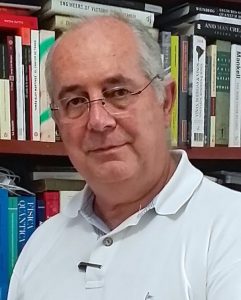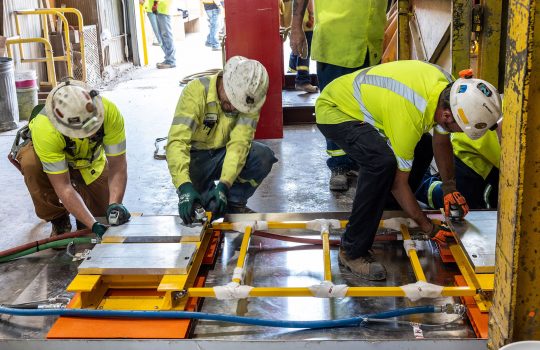For more than 30 years, many Brazilian scientists have called Fermilab experiments their scientific home. The partnership between Fermilab and scientists from Brazil dates back to the 1980s, when the laboratory brought four young scientists to Illinois to conduct research for two years before returning to their home institutions in São Paulo and Rio de Janeiro. Today, about 80 scientists and students from 16 Brazilian institutions participate in Fermilab experiments, including the neutrino experiments DUNE, NOvA and MINERvA and the Dark Energy Survey.
The Brazilian Center for Research in Physics (Centro Brasileiro de Pesquisas Físicas, or CBPF) was the home of three of the four Brazilians who made the first trek to Fermilab in 1984 and today remains a leading institution for particle physics research in Brazil.
During a visit to Fermilab at which representatives from global funding agencies discussed the progress of and support for the Long-Baseline Neutrino Facility and Deep Underground Neutrino Experiment as part of the Resources Review Board, CBPF Director Ronald Shellard discussed the past, present and the future of collaboration between Brazilian scientists and Fermilab.
Q: What were the origins of the connection between Brazilian physicists and Fermilab?
A: The history goes back to the 1980s when [Fermilab Director Emeritus] Leon Lederman wanted to mobilize Latin America to join high-energy physics experiments around the world. Lederman visited many places and corresponded with the Brazilian Physical Society, which at the time was dominated by condensed matter researchers. Lederman offered fellowships to young Brazilians who came to Fermilab, and then they brought their students to Fermilab. That provoked a reaction from CERN, who offered one fellowship to a young Brazilian scientist, which I took.
Fermilab was absolutely essential in creating a large and quite vigorous community of high-energy physics researchers not only in Brazil, but in Latin America.
Q: On which Fermilab experiments did Brazilian scientists leave their mark?
A: The first Brazilian scientists at Fermilab worked on a fixed-target experiment exploring the charm quark. Later, there was a group that joined the DZero collider experiment, which has now moved to the CMS experiment [at the Large Hadron Collider]. Many Peruvian, as well from other Latin American countries, scientists took their degrees in Brazilian institutions on themes associated to Fermilab. Today they have a community in their countries. Also, there is a large collaboration of Brazilians working on the Pierre Auger Observatory. [Fermilab scientist] Paul Mantsch was crucial to making Auger happen on time and on schedule in a period when Argentina had a huge economic crisis.
Now I am here because of my responsibilities as director of CBPF, which is involved in DUNE. As a scientist I have been following with much interest the development of DUNE. It’s an excellent opportunity to have new, young physicists tackling the main, exciting problems in high-energy physics. And neutrino research is one of the windows to solve some of the fundamental questions in particle physics.
Q: How do you see the partnership between Brazil and Fermilab evolving over the next decade?
A: I would like to see an increase in the amount of people in their 30s participating in Fermilab’s flagship experiment, so that they have leadership roles in DUNE in 10 years. I also see the possibility of mobilizing local resources, local industries for providing equipment and services to DUNE, which is very important to creating a solid base for the continued growth of high-energy physics in Brazil. We are at the stage where we need to get involved not only in doing the analysis from the experiment, but actually building parts of it here in Brazil. Some of our younger scientists have already been developing detectors for DUNE.
We, in South America, are also building the ANDES project (which stand for Agua Negra Deep Experimental Site) that we hope to use for neutrino physics. This is connected to a road tunnel under the Andes that will connect Argentina and Chile all year long; the existing tunnel is closed two months a year. We need international collaboration to help fill it [with experimental equipment].
Q: How has high-energy physics research had broader impacts in Brazil?
A: Our high-energy physics community has now reached “adulthood,” and we have people doing great work. We have a light source in Brazil [SIRIUS] in the final stages of construction, a state of the art synchrotron radiation facility, which will be open for all.
There has also been an impact on education. For more than 10 years, high school teachers from Brazil have participated in a CERN course together with colleagues from Portugal. More than 300 teachers have participated from 23 states in Brazil. This has been very successful; they feel part of the scientific enterprise. The impact has been enormous.
Q: Where do you see Brazilian high-energy physics heading next?
A: One of the paradoxes of science is that the more you know, the less you know. We are stuck with a Standard Model and lots of things that don’t fit. In the 1970s when I did my Ph.D., progress was slow. Now it’s fast, even though experiments take a long time to build.
Brazilian science has come a long way. Within my lifetime we went from few scientists to a significant number of people and enough resources to give a big step forward and be more proactive in the experiment where we participate.
We have work to do. We need to spread high-energy physics around our country more; at the moment it is concentrated in the south around Rio de Janeiro and São Paulo. We need to mobilize industry to serve and benefit from these experiments. These things are happening — not at the rate I would like, but they are happening.
For more on CBPF and its relationship to Fermilab and to DUNE, view the video interview with Shellard below.
For more on the history of Brazilian scientific collaboration with Fermilab, read ““Brazil in Batavia: How a timely invitation sparked 30 years of partnership.”




